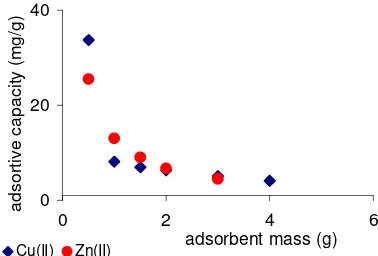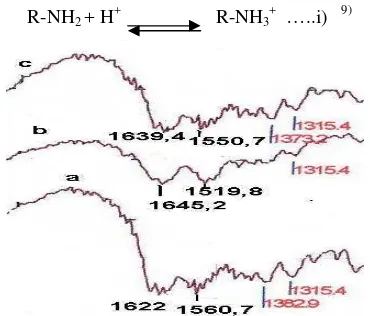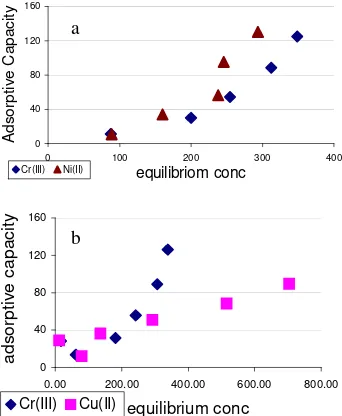Complex Surface Formation Model On Chitosan Adsorption to Metals
Endang W. Laksono , Jaslin Ikhsan and AK. Prodjosantoso1)
Jurdik Kimia, FMIPA, Universitas Negeri Yogyakarta Karangmalang 55281, Yogyakarta
Abstract
The aim of this work is to determine the complex surface formation models between chitosan and metal ions. This prediction is according to the plot adsorptive capacity and the bonding tendency between chitosan and some metals.
Chitosan was isolated from green crab’s shell (Scylla serata and was impurities by 20 %- 30% chitin). The adsorption experiment was carried out at room temperature for 24 hours at pH system 5. A half gram of chitosan was added into 50 mL Cr(III), Ni(II), Cu(II) and Zn(II) metal solutions. Each ion metal was adsorbed by chitosan and some metal ions i.e : Cr(III), Cu(II), and Ni(II) were adsorbed simultaneous. Chitosan was characterized by FTIR. Adsorptive capacity was determined by adsorbed species.
The result of this work concludes that adsorptive capacity of chitosan in order for some metals ion are Cr(III) > Zn(II)> Ni(II) >Cu(II). A multi layer are formatted by active site chitosan and metal ion interactions, but the interaction of chitosan to copper(II) tend to form a mono layer formation.
Keywords
: chitosan, adsorption, multilayerI. Introduction
The highly adsorptive capacity of chitosan to metals can be obtained if we know the adsorption models between chitosan and metal ions. Modified chitosan using impregnant i.e. EDTA-DTPA 1) can be successfully synthesized by understanding the types of chitosan-metal interactions. In the other hand2-4)used chitosan as metal bondings. To increase the adsorptive capacity they combined chitosan with another particular component i.e. succinate acid 3) or prepared resin with chelating agent 4-5) or supported with 3,4 dihydroxylbenzoic acid2)
The previous researchs use chitosan as adsorbent have been done, for example to Cr(III) ion 6), Cu(II) ion 7)and to Co(II) ion and Ni (II) ion 8). An unclear explanation by Warlan 8) confirmed that chitosan and metal has been bonded in complex mechanism. Chitosan as adsorbent have amide functional group can adsorb more powerful than chitin. Chitosan have two functional group -OH and NH2 but never been
compared it. Understanding the functional group in chitosan used in to adsorb metal ions like i.e. Cr(III), Cu(II), Ni(II) and Zn(II) adsorption mechanism is important.
Li Jin and Renbi Bai 9) have impregnated chitosan on PVA (polyvinyl alcohol) as adsorbent to Pb(II) and reported that -NH2
groups capable to bond the metal ions. The –OH groups in pectrochemical series is stronger than –
the -NH2. In addition –OH groups influenced the
acidity of surface or character the surface and the strength or selectivity metal ions bonding 10). This fenomenon is very interesting to understand.
Green crab’s shell that contain chitin and chitosan has not yet been optimally using. Green crab’s shell contain protein (15.67%-23.90%), CaCO3 (53.70% -78.40%) and chitin
(18.70%-32.20%) it depend on kind of crab species and it’s life. Between Cr(III), Zn(II), Ni(II), and Cu(II), Cr(III) is classified as hard base, and the other are soft bases. Active site chitosan are –NH2and –OH
which can react with a selected metal ion. In the adsorptive capacity of chitosan to metal ions, we can determine the type of interaction between metal ions and chitosan.
Adsorptive character between of chitosan to metals ion can be determine by plotting metal ion concentrates in equilibrium to adsorptive capacity. Langmuir’s isotherm shows monolayer formation at the surface. Freundlich’s isotherm shows complex multilayer formation at the surface. There are more than one active functional group at the surface.
II. Experimental methods
refluxed at 65OC. The strained and the reside are using distillated water until neutral at room temperature.
Demineralization is undertaken by mixing residue with chloride acid and refluxing at the 60OC. The strain and reside are washed using water at room temperature .
Deasetylation is undertaken by mixing residue with sodium hydroxide and refluxing on the 100OC . At room temperature the strain and reside are washed with water until neutral. The residue is analyzed using Infra Red Spectrophotometer (FTIR).
To find out the adsorptive capacity of chitosan to metal ions at the equilibrium concentration and the first concentration each metal ions is compared. The concentration of metal ions is measured by Atomic Adsorption Spectrophotometer (AAS). Adsorbent mass and pH of the system were first optimized. Optimation of adsorbent mass use Cu(II) and Zn(II) at 500 ppm and Ni(II) at pH system optimum. The selected pH must be supported by surface acidity. The surface acidity was measured according to gravimetric method. The more quantity of ammoniac gas were adsorbed on chitosan the more acidity of surface.
The adsorption experiment was carried out at room temperature for 24 hours at pH of 5. The weight of adsorbent used for the adsorption is 1/100 (b/v). Concentration of metal ions are between 200 ppm to 1600 ppm. Adsorption was carried out for each metal ions and simultaneous for several metal ions i.e. Cr(III): Cu(II) and Ni(II).
III. Result and Discussion
Mass and pH Optimum
Figure 1. shows the adsorbent mass optimum. Adsorptive capacity of chitosan to Cu(II) and Zn (II) seem similar. The maximum adsorptive capacity of chitosan both Cu(II) and Zn (II) are obtained at 0,5 g/ 50 mL ion solution.
The adsorptive capacity measurement of chitosan to Ni(II) at various pH system shows the adsorptive capacity optimum at pH 5.0. At this condition, the surface have acidity of 8.8 g. It means that at pH system of 5.0 the surface is more acid. This condition supports the adsorption process. The surface acidity influence the adsorptive capacity of chitosan. Because the metal ions have positive charge, the negative charge of surface support to form complex- adsorption.
0
Figure 1. Corelation between adsorbent mass and adsorptive capacity of chitosan
Table.1. Adsorptive Capacity of Chitosan to Ni(II) at various pH system and surface acidity
pH system Surface
5.0 8.81g 20.00 mg/g
5,6 -- 18.03 mg/g
Metal ions Adsorption
Adsorptive capacity of chitosan to metal ions towards equilibrium concentration of metal ion solutions were performed in Figure 2. This figure shows that adsorptive capacity of chitosan to Cr(III) is highest and Cr(III) ions reach equilibrium more rapid than Zn(II), Ni(II) and Cu(II).
Cu(II) Ni(II) Zn(II) Cr(III)
The isotherm curve of Cu(II) form the L curve, it means adsorbent have high affinity in low concentration of metal ion 11). Interaction between active site on surface and metal ions decrease the surface active site, so that at higher concentration of metal ions the lower adsorptive capacity. Contrary with the adsorption behavior of chitosan to Cr(III), Zn(II) and Ni(II) form S isotherm curves. At the low concentration of metal ions chitosan is affinited to low and vice verca.
The type of isotherm is related to the adsorptive behavior of chitosan to metal ions. Formation of the S curve is related with Freundlich isotherm, and the L curve perform Langmuir isotherm. Performance of adsorptive behavior for each metal ion in Figure 2 is different. Adsorption of chitosan to Cr(III), Ni(II) and Zn(II) ions is form Freundlich isotherm. The adsorption of chitosan to Cu(II) ion form Langmuir isotherm.
The type of isotherm is determined using a value of linearity (r) of isotherm. We can conclude that Cr(III), Zn(II) and Ni(II) follows Freundlich type than Langmuir , but the adsorptive behavior of Cu(II) is Langmuir type (table 2).
Table 2. Value of r on relation graph between adsorptive capacity of chitosan and equilibrium concentration metal ions
Metal ion r for Langmuir Isotherm
Based on the adsorptive capacity in Figure 2, we observe that adsorptive capacity in of some metals ion are Cr(III) > Zn(II)> Ni(II) >Cu(II) at equilibrium concentration.
Identified of Functional group cluster isolated of chitosan using spectroscopy of infrared (FTIR) in figure 3a. The functional groups of chitosan at pH system of 5 spectra can be seen on the Figure 3b, and the functional groups of chitosan after adsorbing metal ions shown in Figure 3c. Vibration of NH of amine and NH cluster are indicated by band between 1560,7 cm-1 and 1550,7 cm-1 (Fig.3). The premiere amine (NH2) of chitosan is appeared at 1560,7 cm-1(Fig.
3c)
This term indicate amine used on the adsorption process. Chitosan on the watery form or base will react as follows :
R-NH2+ H+ R-NH3+ …..i) 9)
Figure 3. Spectra IR of Chitosan (a), chitosan at pH system of 5 (b) and after adsorbing to metal ion (c)
In Figure 3, this reaction is shown by band movement from 1560,7 cm-1to 1519,8 cm-1 12-14) In the experiment the active pH is pH 5 so that cluster amine changes in to ion R-NH3which
metal ions still bound up on the surface of chitosan, so on the chitosan before and after adsorption indicate NH2 adsorption movement
from 1519 cm-1to 1550,7 cm-1(Fig.3) and there is possibility use less of NH2to bond metal ion.
The possibility react ion is :
R- NH2 + M2+ R-NH2M2+ ..ii)
R- NH3++ M2+ R- NH2M2++ H+ iii)
After adsorption, multi layer are formed as –OH groups of chitosan bind the metal ions. The –OH groups of chitosan at higher pH (between 4 and 5) were protonated 9):
R – OH + OH-↔ RO-+ H2O...iv)
RO-+ M+ ↔ ROM ...v)
RO- group are inner sphere. The ROM (reaction v) is formed only in metal ion atmosphere which is hard base or trantition. Reaction iv) and v) are indicated by band movement of -OH groups from 1622 cm-1 to 1645 cm-1 and finally at 1639,4 cm-1 (Fig.3) Contrary Cu(II) is enable to form RO-Cu because Cu(II) is soft base and that is indicated in Figure 2. It is no sure, but it is possible the formation of multilayer at concentrated Cu(II).
The Cr(III), Ni(II) ,Cu(II) ion
simultaneous adsorption
adsorptive capacity of chitosan to Cr(III) is higher than others. Comparing to those of adsorption chitosan-each metal ion, the experiment data show similarity, but chitosan adsorbs more Cr(III).
0 40 80 120 160
130 135 140 145 150
equilibrium concentration
Figure 4. Adsorptive Isotherms Curve of Chitosan to simultant Cr(III), Cu(II) and Ni(II)
0
0.00 200.00 400.00 600.00 800.00
equilibrium conc
Figure 5. Adsorptive Isotherms Curve of Chitosan to Cr(III), Ni(II) (a) and Cr(III), Cu (II) (b) simultaneous
Figure 5 b) shows the adsorption of chitosan to Cr(III) higher than that Cu(II). Figure 5 a) shows an inconsistency that Cr(III) is more adsorbed than the other ions. At low concentration the chitosan adsorb, Ni(II) ion similar to the Cr(III) ion. It is possible that chitosan-Cr(III) ions interaction reached equilibrium first compare to chitosan-Ni(II)
IV. Conclusion
Adsorptive capacity of chitosan to some metals ion are Cr(III) >Zn(II)> Ni(II) > Cu(II) at equilibrium concentration. The chitosan interaction to metal ions is an ionic interaction and indicates a complex surface formation by
-NH2 groups or –OH groups. A multilayer are
formatted by active site chitosan and metal ion interactions, but the interaction of chitosan to copper(II) is tend to forms a monolayer
V. Reference
1. Katutoshi I, Kazuharu Y, Keisuke O, Analytica Chemica Acta, 388, 1-2, 209-218 (1999)
2. Sabarudin A, Oshima M, Takayanagi T, et al, Analytica Chemica Acta,In Press, online 18 August 2006
3. Ebru B, Arzu E, Adil D, Ridvan S, Analyca Chemica Acta, 565, 2, 145-151, (2006) 4. Ketrin KR, Takayanagi T, Oshima M, et al,
Analytica Chemica Acta, 558, 1-2, 246-253. (2006)
5. Amarildo OM, Edson LS, Eduardo C et al. Analytical Chemica Acta, 521, 2, 157-163 (2004)
6. Adriana, Mudjiati, Selvy Elvira, dan Vera Setijawati. (2001). Adsorpsi Cr(VI) dengan Adsorben Khitosan. Jurnal Kimia Lingkungan. 3(1) : 32-34.
7. Ika S. Wahyuningtyas. Sintesis Khitosan dari Udang dan Uji Daya Adsorpsinya terhadap Ion Cu (II). Skripsi. Yogyakarta: FMIPA UNY(2003).
8. Warlan Sugiyono. Jurnal MIPA (4):26-39. Universitas Negeri Semarang. (2002)
9. Lie Jin and Bai, R. Mechanisms of Lead Adsorption on Chitosan/PVA Hydrogel Beads.Langmuir. 18(25) : 9765-9770. (2002). 10. Endang W. Laksono. Studi Keasaman Permukaan Nikel Berhidroksil secara Spektroskopi Inframerah. Prosiding Seminar Nasional Kimia: 49-54. (2002).
11. McCash, E.M.Surface Chemistry. New York : Oxford University Press. (2001).
12. B. Afsin, P.R. Davis, A. Pashusky, M.W. Robert, and D. Vincent. Surfaces. Surface Science. 284 : 109-120. (1993)
13. H.E. Dastoor, P. Gardner, and D.A. King.
Surface Science. 289 : 279-289. (1993). 14. Ming-Cheng Wu, Truong, Charles M., and
Goodman, Wayne. Physical Chemistry. 97 : 4182-4186. (1993)
Acknoledgement
The works was supported by the DP2M DIKTI DEPDIKNAS Indonesia .
a


